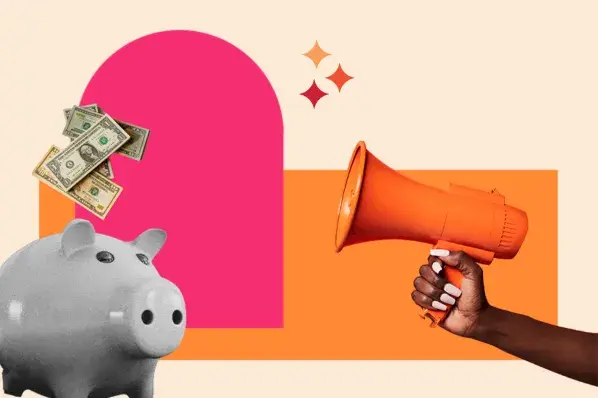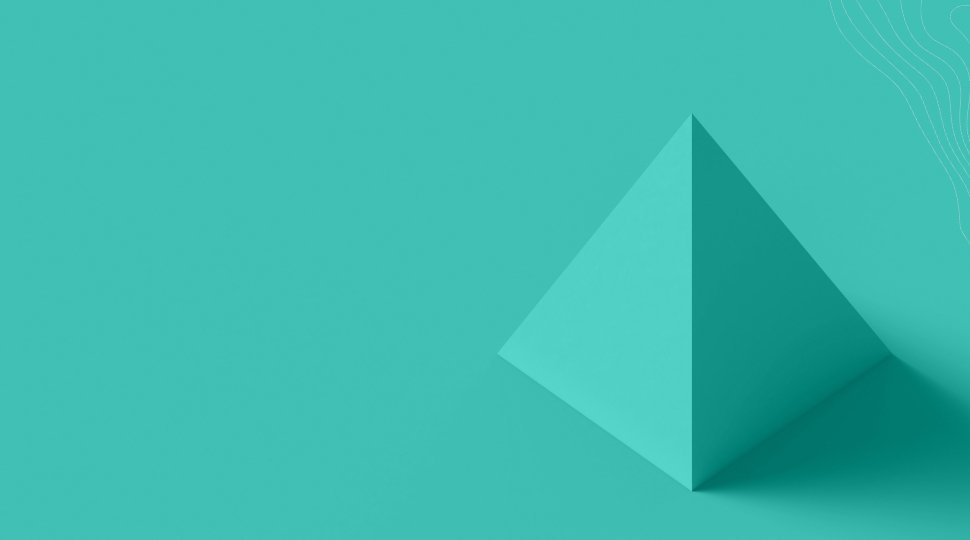Grab a Pillow and Get Comfy for This 20-Minute Relaxing Yoga Flow
These four poses are sure to help you decompress.

At some point in time during the COVID lockdown, I found myself lying on my yoga mat with five or six different props—yoga blankets, an eye pillow, yoga strap, two blocks, and of course, my cylindrical navy blue yoga bolster—wedged into every crevice between my body and the floor.
This cozy arrangement of props was part of the curriculum for a teacher training I was completing on restorative yoga and the nervous system, but somewhere between opening my hips and deepening my breath, I realized I had seriously underestimated the power of a prop to make lasting positive change in my body and mind. This prop was my bolster (often referred to as a yoga pillow)—something I’d owned for years, but only occasionally used because, well, I just had no idea how to really use it.
Now, three years later, I still reach for my bolster when I’m struggling to deal with stress because I know if I relax my body, I can ultimately relax my mind and find balance again. Read on to learn more about the benefits of using one and how to incorporate it into your practice—along with a few tips from another yoga teacher and bolster devotee.
The benefits of a yoga bolster that’ll convince you to add it to your practice
A yoga bolster is a soft and supportive prop designed to help you reach a whole new level of total relaxation, both on and off the mat. Bolsters are a squishy staple of restorative yoga, which is a gentle practice that has you drape yourself over yoga props for three to 20 minutes at a time, with the goal of completely relaxing your body to slowly yet surely shift your nervous system into a state of deep rest.
Unlike firm yoga blocks, a strap, or even yoga blankets, which are great, but also require a bit of time and knowledge to get set up, a bolster is simple and easy to use just as it is, delivering an almost instant calm the moment you recline into its comforting embrace.
Plus, it can be folded into a more vigorous yoga practice, as a gentle way to transition into savasana (corpse pose), as well as in daily life, where it can work magic to help unwind the knots of physical, mental, and emotional stress. But don’t just take it from me. Divya Balakrishnan, E-RYT 200, a New York City-based registered yoga teacher, also uses bolsters in her personal practice and while teaching classes.
“The release you get by using a bolster can benefit you in so many ways,” Balakrishnan says. “In instances when I use it to open my body, I find it boosts blood circulation and allows for muscular release. It also puts my mind at ease, shifting my attention away from the effort of the posture to the sensation of release. My students and I use bolsters in my restorative classes to embody ‘sukham,’ or the yogic concept of ease.”
Sure, lounging on a yoga bolster doesn’t appear all that complicated. And that’s sort of the point—it’s meant to feel easy enough so you can let go and surrender to simply being in the pose. And let’s face it, sometimes letting go of tension and focusing only on the present moment can be hard when that isn’t something you’re used to doing.
According to Balakrishnan, this is where time, a mindful awareness of yourself, and bolsters work together in harmony to help you make an important shift.
“Bolsters can be used for as long as it takes for you to release the hold and tension you have in your muscles,” she says. “For some, that can be five breaths, for others that might be five minutes. The key is to breathe into the posture and allow your tension to transfer to the bolster and leave you at ease.”
This gentle 20-minute flow uses only a yoga mat and a bolster. While there’s a suggested length of time to practice each pose, it’s up to you to decide how long you’ll stay in each one depending on how your body feels. Find a peaceful space, grab your bolster, and give it a try!
“The release you get by using a bolster can benefit you in so many ways…My students and I use bolsters in my restorative classes to embody ‘sukham,’ or the yogic concept of ease.” —Divya Balakrishnan, E-RYT 200
A 20-minute relaxing flow
1. Supported child’s pose (Balasana)
Use your bolster in child’s pose to make this classic relaxation posture even more calming.
“My favorite way to use bolsters is by placing them under my body in floor postures, such as bridge pose or child’s pose. The firm support underneath me helps me relax my core and back and stay in the posture longer, allowing for that wonderful deep muscular release,” Balakrishnan says.
You can place a folded blanket or two over top of your bolster to raise it higher if that feels more comfortable. Alternatively, you can slide a yoga block underneath the top on whatever height feels right for more support.

- Begin sitting on your heels with your knees hip-width apart and place your bolster lengthwise in between your legs as close to you as possible.
- Inhale and elongate your spine, then as you exhale gently lower yourself down to the bolster and rest your arms on the floor alongside you.
- Turn your head to one side and set a timer for three to five minutes. Turn your head to the other side halfway through.
- Slowly lift yourself back to sitting and take a few more slow deep breaths before moving.
2. Restorative twist
This twisting pose is made even better with the addition of a bolster. Just like in child’s pose, you can stack a folded blanket on top or slide a yoga block beneath the top third to raise it higher. You can also place a pillow or another folded blanket in between your legs for extra cushion.

- With your bolster in the same lengthwise position on your mat as above, place your right hip against the short edge of the bolster, leaving a couple inches of space in between.
- Bend your knees with your top shin resting on top of the arch of your bottom foot.
- Inhale to elongate your spine and exhale to turn your torso toward the bolster before lowering down onto your right side, keeping the belly free to expand with your breath.
- Set a timer for three to five minutes, then lift yourself up to switch sides.
3. Supported bridge pose (Setu Bandhasana)
Practice bridge pose with the support of a bolster to bear the weight of your pelvis and release your spinal muscles. This supported pose is a wonderful antidote to headaches, low back tension, and fatigue. Got a yoga strap? Secure it around the middle of your thighs so your leg muscles can fully relax as well for a truly luxurious five minutes …or more!

- Place your bolster widthwise across the middle of your mat, just a little below center.
- Bend your knees and sit against the long edge of the bolster.
- Then gently lift your hips up to place the back of your pelvis on top of the pillow before slowly lowering your head and neck down onto the mat.
- Carefully reposition your pelvis so the top rim of your hips lines up with the top edge of your bolster. This allows your lower back to hang freely, almost like a hammock, to create a traction in the spine for a gentle release. Make sure you don’t jam your chin into your chest, and if you feel any neck pain, exit the pose right away.
- Let your arms rest alongside you, or bend your elbows into a cactus shape.
- Set a time for five to 10 minutes and relax into the pose.
- Gently roll yourself off the bolster to come out of the pose.
4. Supported cobbler’s pose (Supta Baddha Konasana)
Sink into your deepest relaxation by practicing cobbler’s pose at the very end of this sequence. A single bolster will help open the chest for a fuller breath, relax your spine, and gently open up your belly and pelvis. Wrap a blanket around your ankles and tuck your feet in if you start to feel cold, and try an eye pillow for less sensory stimulation. The cozier and darker, the better!

- Set up your bolster lengthwise in the middle of your mat and sit up against the short edge at the bottom.
- Inhale to elongate your spine and lie back onto the bolster, then bring the soles of your feet together.
- Use any other props, like a blanket or eye pillow to make the adjustments you need.
- Relax your arms alongside you or place them on your heart or belly (or place one hand on your heart and the other on your belly).
- Set a timer for five to 10 minutes and relax into the pose.
- Gently press yourself up to exit the pose, and pause for a few slow breaths before standing up.
4 yoga bolsters to open your body and calm your mind
Ready to sink into the soft support of a yoga bolster but don’t know where to look? This curated shortlist rounds up some of our favorite bolsters in different shapes and sizes, so you can decide which one is best for you.

“For asana, I typically like to use a rectangular or cylindrical bolster, as the shape is versatile and can be used in many configurations to support you,” Balakrishnan says. “I love Manduka bolsters—they’re great quality, holding their shape while adapting to your body.”

Round bolsters easily slide under your back to open up your chest and support your knees when you’re lying on your back. These round bolsters by Hugger Mugger are the perfect shape, and have a removable, washable cover. They also come in smaller sizes for different bodies.

The popular mattress brand also offers a small collection of yoga bolsters and meditation pillows made with soft organic cotton. The inside is filled with vegan buckwheat hulls rather than foam for an even more adaptable pillow that molds itself to your shape.

“I love using a small round, flat cushion to sit on when I am meditating or practicing pranayama,” Balakrishnan says. “It makes my seat more comfortable, which allows me to focus all my attention on my practice.” Check out Manduka’s take on a meditation cushion, made with the same comfortable springy wool and microfiber as their bestselling rectangular bolster (above).
What's Your Reaction?









![The HubSpot Blog's Marketing Leadership Report: How 720+ Brand Leaders Will Get Ahead in 2025 [+ How to Join Them]](https://www.hubspot.com/hubfs/Copy%20of%20The%20Future%20of%20Work%20is%20Flexible%20%5BImage%2c%20IG%5D%20%28598%20%C3%97%20398%20px%29%20%28595%20%C3%97%20400%20px%29%20%28517%20%C3%97%20517%20px%29.png)





























.png)












































